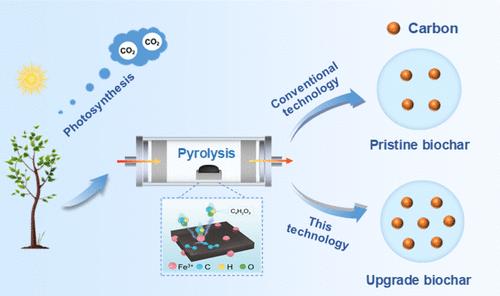当前位置:
X-MOL 学术
›
ACS Sustain. Chem. Eng.
›
论文详情
Our official English website, www.x-mol.net, welcomes your
feedback! (Note: you will need to create a separate account there.)
Enhanced Carbon Sequestration of Sustainable Biochar via Metal Salt Regulation: Insight into Reaction Mechanism and Carbon Footprint
ACS Sustainable Chemistry & Engineering ( IF 7.1 ) Pub Date : 2024-11-06 , DOI: 10.1021/acssuschemeng.4c07181 Shaojie Zhou, Qi Wang, Qian Wang, Xiangdong Zhu, Jiajun Fan, James H. Clark, Bin Chen, Shurong Wang, Yutao Wang, Shicheng Zhang
ACS Sustainable Chemistry & Engineering ( IF 7.1 ) Pub Date : 2024-11-06 , DOI: 10.1021/acssuschemeng.4c07181 Shaojie Zhou, Qi Wang, Qian Wang, Xiangdong Zhu, Jiajun Fan, James H. Clark, Bin Chen, Shurong Wang, Yutao Wang, Shicheng Zhang

|
Sustainable biochar can sequester carbon and therefore, mitigate climate change. However, only a small fraction of biomass carbon is retained during biochar synthesis, greatly restricting its carbon-sequestration capacity. A significant boost of the carbon-sequestration potential of biochar has so far been a challenge. This study reveals that when biochar is modified by FeCl3, its carbon-sequestration capacity is boosted to 247.73% of that of pristine biochar derived at 500 °C. Meanwhile, pristine biochar retains only 43.18% of its biomass carbon, while FeCl3-modified biochar retains 75.20% of its carbon by forming complexes between the iron salts and the carboxyl- and hydroxyl-rich organic compounds derived from biomass pyrolysis. As react proceeds, the complexes are further converted into ferrites and organic carbon. The resulting minerals provide physical barriers against carbon decomposition, further enhancing the long-term stability of biochar. Life cycle assessment results further show that ferric salt can markedly enhance the greenhouse gas─reduction potential of biomass-to-biochar-to-soil systems. The more cycles from biomass to upgraded biochar, the more potent the carbon-negative effect is. Undoubtedly, such discoveries hold significant implications for accelerating carbon neutrality.
中文翻译:

通过金属盐监管增强可持续生物炭的碳封存:反应机理和碳足迹洞察
可持续的生物炭可以封存碳,从而缓解气候变化。然而,在生物炭合成过程中,只有一小部分生物质碳被保留,极大地限制了其碳封存能力。迄今为止,显著提高生物炭的碳封存潜力一直是一个挑战。本研究显示,当生物炭经 FeCl3 改性时,其固碳能力提高到 500 °C 下原始生物炭的 247.73%。 同时,原始生物炭仅保留了 43.18% 的生物质碳,而 FeCl3 改性生物炭通过在铁盐与生物质热解衍生的富含羧基和羟基的有机化合物之间形成复合物来保留 75.20% 的碳。随着反应的进行,络合物进一步转化为铁氧体和有机碳。由此产生的矿物质为碳分解提供了物理屏障,进一步增强了生物炭的长期稳定性。生命周期评估结果进一步表明,铁盐可以显著提高生物质-生物炭-土壤系统的温室气体减排潜力。从生物质到升级生物炭的循环次数越多,负碳效应就越有效。毫无疑问,这些发现对加速碳中和具有重要意义。
更新日期:2024-11-06
中文翻译:

通过金属盐监管增强可持续生物炭的碳封存:反应机理和碳足迹洞察
可持续的生物炭可以封存碳,从而缓解气候变化。然而,在生物炭合成过程中,只有一小部分生物质碳被保留,极大地限制了其碳封存能力。迄今为止,显著提高生物炭的碳封存潜力一直是一个挑战。本研究显示,当生物炭经 FeCl3 改性时,其固碳能力提高到 500 °C 下原始生物炭的 247.73%。 同时,原始生物炭仅保留了 43.18% 的生物质碳,而 FeCl3 改性生物炭通过在铁盐与生物质热解衍生的富含羧基和羟基的有机化合物之间形成复合物来保留 75.20% 的碳。随着反应的进行,络合物进一步转化为铁氧体和有机碳。由此产生的矿物质为碳分解提供了物理屏障,进一步增强了生物炭的长期稳定性。生命周期评估结果进一步表明,铁盐可以显著提高生物质-生物炭-土壤系统的温室气体减排潜力。从生物质到升级生物炭的循环次数越多,负碳效应就越有效。毫无疑问,这些发现对加速碳中和具有重要意义。


















































 京公网安备 11010802027423号
京公网安备 11010802027423号